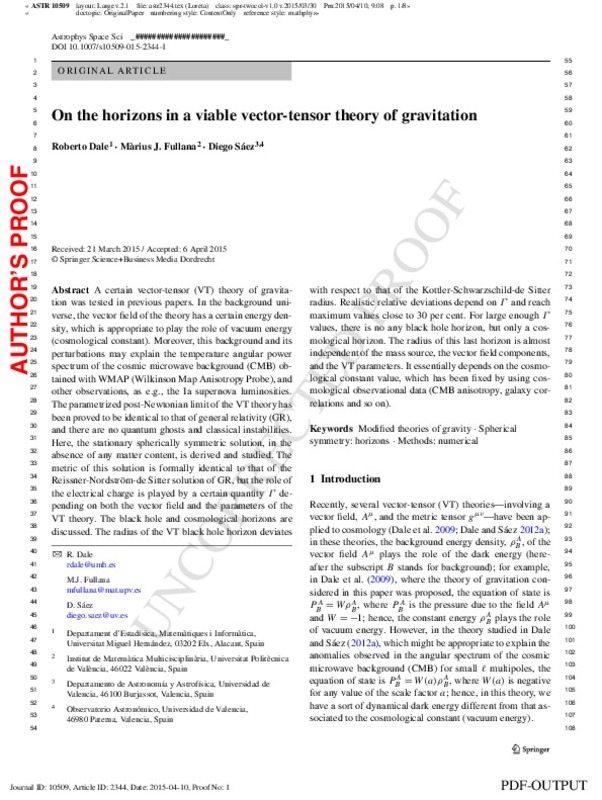JavaScript is disabled for your browser. Some features of this site may not work without it.
Buscar en RiuNet
Listar
Mi cuenta
Estadísticas
Ayuda RiuNet
Admin. UPV
On the horizons in a viable vector-tensor theory of gravitation
Mostrar el registro sencillo del ítem
Ficheros en el ítem
| dc.contributor.author | Dale, Roberto
|
es_ES |
| dc.contributor.author | Fullana Alfonso, Màrius Josep
|
es_ES |
| dc.contributor.author | Saez Milán, Diego Pascual
|
es_ES |
| dc.date.accessioned | 2016-04-18T16:10:27Z | |
| dc.date.available | 2016-04-18T16:10:27Z | |
| dc.date.issued | 2015-06 | |
| dc.identifier.issn | 0004-640X | |
| dc.identifier.uri | http://hdl.handle.net/10251/62731 | |
| dc.description | The final publication is available at Springer via http://link.springer.com/article/10.1007%2Fs10509-015-2344-1 | es_ES |
| dc.description.abstract | A certain vector-tensor (VT) theory of gravitation was tested in previous papers. In the background universe, the vector field of the theory has a certain energy density, which is appropriate to play the role of vacuum energy (cosmological constant). Moreover, this background and its perturbations may explain the temperature angular power spectrum of the cosmic microwave background (CMB) obtained with WMAP (WilkinsonMap Anisotropy Probe), and other observations, as e.g., the Ia supernova luminosities. The parametrized post-Newtonian limit of the VT theory has been proved to be identical to that of general relativity (GR), and there are no quantum ghosts and classical instabilities. Here, the stationary spherically symmetric solution, in the absence of any matter content, is derived and studied. The metric of this solution is formally identical to that of the Reissner-Nordstrom-de Sitter solution of GR, but the role of the electrical charge is played by a certain quantity G depending on both the vector field and the parameters of the VT theory. The black hole and cosmological horizons are discussed. The radius of the VT black hole horizon deviates with respect to that of the Kottler-Schwarzschild-de Sitter radius. Realistic relative deviations depend on G and reach maximum values close to 30 per cent. For large enough G values, there is no any black hole horizon, but only a cosmological horizon. The radius of this last horizon is almost independent of themass source, the vector field components, and the VT parameters. It essentially depends on the cosmological constant value, which has been fixed by using cosmological observational data (CMB anisotropy, galaxy correlations and so on). | es_ES |
| dc.description.sponsorship | This research has been supported by the Spanish Ministry of Economia y Competitividad, MICINN-FEDER project FIS2012-33582. | en_EN |
| dc.language | Inglés | es_ES |
| dc.publisher | Springer Netherlands | es_ES |
| dc.relation.ispartof | Astrophysics and Space Science | es_ES |
| dc.rights | Reserva de todos los derechos | es_ES |
| dc.subject | Modified theories of gravity | es_ES |
| dc.subject | Spherical symmetry: horizons | es_ES |
| dc.subject | Methods: numerical | es_ES |
| dc.subject.classification | MATEMATICA APLICADA | es_ES |
| dc.title | On the horizons in a viable vector-tensor theory of gravitation | es_ES |
| dc.type | Artículo | es_ES |
| dc.identifier.doi | 10.1007/s10509-015-2344-1 | |
| dc.relation.projectID | info:eu-repo/grantAgreement/MINECO//FIS2012-33582/ES/GRAVITACION, POSICIONAMIENTO RELATIVISTA Y COSMOLOGIA/ | es_ES |
| dc.rights.accessRights | Abierto | es_ES |
| dc.contributor.affiliation | Universitat Politècnica de València. Departamento de Matemática Aplicada - Departament de Matemàtica Aplicada | es_ES |
| dc.description.bibliographicCitation | Dale, R.; Fullana Alfonso, MJ.; Saez Milán, DP. (2015). On the horizons in a viable vector-tensor theory of gravitation. Astrophysics and Space Science. 357(2):116-124. https://doi.org/10.1007/s10509-015-2344-1 | es_ES |
| dc.description.accrualMethod | S | es_ES |
| dc.relation.publisherversion | https://dx.doi.org/10.1007/s10509-015-2344-1 | es_ES |
| dc.description.upvformatpinicio | 116 | es_ES |
| dc.description.upvformatpfin | 124 | es_ES |
| dc.type.version | info:eu-repo/semantics/publishedVersion | es_ES |
| dc.description.volume | 357 | es_ES |
| dc.description.issue | 2 | es_ES |
| dc.relation.senia | 301212 | es_ES |
| dc.identifier.eissn | 1572-946X | |
| dc.contributor.funder | Ministerio de Economía y Competitividad | es_ES |
| dc.description.references | Bamba, K., Odintsov, S.D.: J. Cosmol. Astropart. Phys. 04, 024 (2008) | es_ES |
| dc.description.references | Bardeen, J.M.: Phys. Rev. D 22, 1882 (1980) | es_ES |
| dc.description.references | Dale, R., Morales, J.A., Sáez, D.: arXiv:0906.2085 [astro-ph] (2009) | es_ES |
| dc.description.references | Dale, R., Sáez, D.: Astrophys. Space Sci. 337, 439 (2012a) | es_ES |
| dc.description.references | Dale, R., Sáez, D.: Phys. Rev. D 85, 124047 (2012b) | es_ES |
| dc.description.references | Dale, R., Sáez, D.: Phys. Rev. D 89, 044035 (2014) | es_ES |
| dc.description.references | Golovnev, A., Mukhanov, V., Vanchurin, V.: J. Cosmol. Astropart. Phys. 06, 009 (2008) | es_ES |
| dc.description.references | Kayll, L.: Phys. Rev. D 19, 421 (1979) | es_ES |
| dc.description.references | Kottler, F.: Ann. Phys. 361, 401 (1918) | es_ES |
| dc.description.references | Lewis, A., Bridle, S.: Phys. Rev. D 66, 103511 (2002) | es_ES |
| dc.description.references | Ma, C.P., Bertschinger, E.: Astrophys. J. 455, 7 (1995) | es_ES |
| dc.description.references | Nojiri, S., Odintsov, S.D.: Phys. Lett. B 735, 376 (2014) | es_ES |
| dc.description.references | Novello, M., Perez Bergliaffa, S.E.: Phys. Rep. 463, 127 (2008) | es_ES |
| dc.description.references | Stephani, H., et al.: Exact Solutions of Einstein’s Field Equations. Cambridge University Press, Cambridge (2003) | es_ES |
| dc.description.references | Will, C.M.: Theory and Experiment in Gravitational Physics. Cambridge University Press, Cambridge (1993) | es_ES |







![[Cerrado]](/themes/UPV/images/candado.png)

